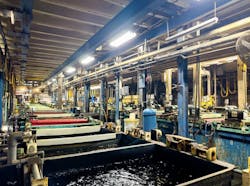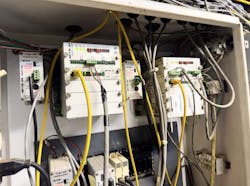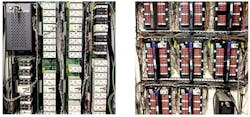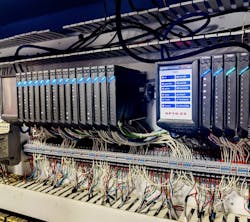Varland Plating, based in Cincinnati, Ohio, has specialized in providing high quality, precision barrel plated finishes for nearly 80 years. Electroplating improves the durability, corrosion resistance, and aesthetic appeal of metal objects by coating them with a thin layer of another metal, using an electric current.
Operating as a job shop specializing in bulk barrel electroplating, Varland Plating processes thousands of different parts for hundreds of different customers across a range of industries, including:
- Automotive components such as internal engine parts to fasteners used on fuel covers.
- Military parts that are used in a wide range of applications, including next generation military vehicles.
- Firearm components and ammunition.
- Fasteners and components for furniture and retail.
- Electrical components such as individual breaker components.
For years, Varland performed plating operations manually, but electroplating is a complex process. For example, barrel plating requires:
- Controlling barrel rotation speed and direction with variable frequency drives (VFDs).
- Tracking the movement of parts throughout the plating line, including tracking how long parts spend in each step of the process.
- Maintaining precise vat temperatures, fluid levels and pH/conductivity readings.
- Managing automated chemical feeds.
- Applying and tracking precise electrical current using a rectifier to facilitate electrolysis, resulting in the deposition of metal ions onto the components.
Varland engineers began automating plating processes in the early 1990s. Their decision to use Opto 22’s SNAP-LCM4 controllers, mistic racks with G4 single-point I/O and FactoryFloor flowchart-based programming software helped Varland establish a reputation in the industry.
Toby Varland, vice president of technology, explained, “Our early adoption of electroplating automation allowed us to excel in producing high-quality work for challenging jobs. This also enabled us to offer better-than-average turnaround times and consistent product quality.”
Serial to Ethernet
The automation steps taken by the company in the 1990s advanced Varland’s business objectives for decades, but as time marched on the limitations of its legacy hardware became evident.
“Every barrel on our automatic plating lines has an RFID (radio frequency identification) tag and our hoists use serial RFID readers to help us track jobs through production. Each SNAP-LCM4 controller supports a maximum of four serial ports. At least one of those ports had to be reserved for I/O, so we were limited to a maximum of three RFID readers per controller,” said Varland.
The limited number of serial ports necessitated daisy-chaining dozens of I/O racks on individual serial communication ports and, in some cases, expanding the architecture to add additional processors. This setup led to increased communication latency, potential data collisions and complicated troubleshooting, ultimately hindering system performance and reliability.
Varland saw that a single GRV-CSERI-4 serial module on Opto 22’s latest groov EPIC (Edge Programmable Industrial Controller) system supports four serial ports, and a single EPIC processor can support up to four of those modules, equating to 16 individual serial connections on one controller.
“Hooking up RFID readers to serial modules on EPIC allows us to condense to a single processor per plating line,” Varland said.
And while serial communications still have their place in Varland’s production process, Varland knew that Ethernet, not serial communication, is the future of industrial automation.
“We could theoretically keep running SNAP-LCM4 processors,” Varland asserts. “Most of our systems have been running reliably for many, many years. But these newer [groov] products just have so much more capability in every aspect, from installation to programming to operator experience, that they do a great job of getting out of the way and making it easier for our staff to do their jobs.”
I/O upgrade
A common pain point in upgrading control systems is replacing and rewiring I/O. With several thousand digital and analog I/O points running key systems at Varland Plating, Varland said rip-and-replace was not seen as a viable upgrade path because shutting down the entire operation is simply not an option. In response, Varland put a lot of thought into the upgrade path and decided to upgrade I/O systems one rack at a time.
Of course, LCM4 processors running FactoryFloor software from the 1990s can’t directly address I/O registers on a brand new groov EPIC I/O rack. But a clever workaround enabled Varland to avoid a costly downtime situation. Taking advantage of Opto 22’s scratch pad—a temporary memory storage area for data exchange between controllers and I/O processors—Varland can map EPIC’s I/O channels to internal memory registers their legacy SNAP-LCM4 controllers can access.
Open communication between legacy and new equipment enables Varland Plating to maintain the existing program on legacy hardware while developing a new one in parallel.
“So, the control logic on the LCM4 doesn’t change. We can start developing a new solution on the groov EPIC. For testing, I can flip a switch, do some testing and then flip back to the old program,” Varland confirmed.
Analytic insight into operations
With critical process variables now available in an Ethernet communication interface, Varland faced their next challenge: Limited visibility and no long-term trend analysis.
A savvy use of free resources helped Varland advance the company’s understanding of its processes with some software development—specifically, a homegrown data historian.
Using Opto 22’s open-source friendly REST API, Varland deployed a suite of PHPTM command-line scripts to retrieve I/O and critical data values and log them into an InfluxDB time series database. The data is then visualized and contextualized using Grafana, an open-source monitoring platform.
Varland’s homegrown data historian was a step forward, but scaling homemade data collection scripts is challenging. As the system grows, maintaining continuity poses a risk, especially if the original developer becomes unavailable. They needed a scalable platform with professional support and documentation to ensure long-term reliability in
SCADA.
“Through groov EPIC, we learned about [Inductive Automation’s] Ignition, and we feel we can leverage the software to accomplish a lot of SCADA goals that we haven’t yet hit,” Varland said. “We started with an Ignition Edge license on one of our groov EPICs, and I liked it enough that we bought a full Ignition license that we now run on an Apple Mac Studio server.
InfluxDB and Grafana worked really well for long-term storage and trend analysis,” Varland said, but “Ignition allows us to remove the pain point of custom data collection and allows us to use Ignition Historian as a passthrough to get data into InfluxDB more reliably and with significantly less work. Getting data into a historian platform where we can be flexible about how we access and study that data has given us new insights into our processes. We’ve reduced downtime, improved our operator experience, and freed our operators to focus on parts and quality.”
Varland’s future plans include groov EPIC upgrades for several more automated lines, a full migration to Ignition for HMI and SCADA, and exploration of Codesys for IEC 61131-3 compliant PLC programming languages.
Dan White is director of technical marketing at Opto 22.
About the Author
Sign up for our eNewsletters
Get the latest news and updates

Leaders relevant to this article:




